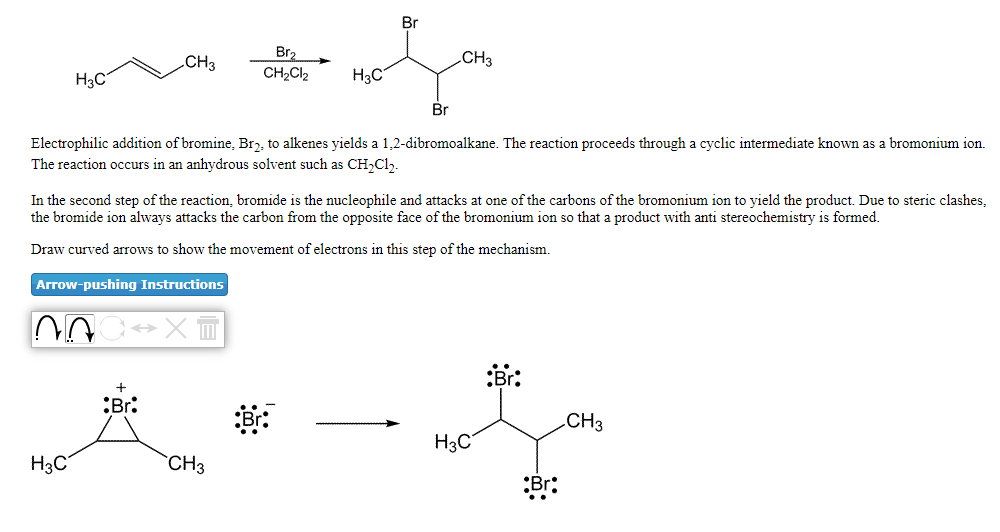Br Br2 CH3 CH3 H3C° CH2Cl2 H3C Br Electrophilic addition of bromine, Br2, to alkenes yields a 1,2-dibromoalkane. The reaction proceeds through a cyclic intermediate known as a bromonium ion. The reaction occurs in an anhydrous solvent such as CH,Cl,. In the second step of the reaction, bromide is the nucleophile and attacks at one of the carbons of the bromonium ion to yield the product. Due to steric clashes, the bromide ion always attacks the carbon from the opposite face of the bromonium ion so that a product with anti stereochemistry is formed. Draw curved arrows to show the movement of electrons in this step of the mechanism. Arrow-pushing Instructions Br: :Br: CH3 H3C H3C CH3 Br:
Br Br2 CH3 CH3 H3C° CH2Cl2 H3C Br Electrophilic addition of bromine, Br2, to alkenes yields a 1,2-dibromoalkane. The reaction proceeds through a cyclic intermediate known as a bromonium ion. The reaction occurs in an anhydrous solvent such as CH,Cl,. In the second step of the reaction, bromide is the nucleophile and attacks at one of the carbons of the bromonium ion to yield the product. Due to steric clashes, the bromide ion always attacks the carbon from the opposite face of the bromonium ion so that a product with anti stereochemistry is formed. Draw curved arrows to show the movement of electrons in this step of the mechanism. Arrow-pushing Instructions Br: :Br: CH3 H3C H3C CH3 Br:
Chapter17: Alcohols And Phenols
Section17.SE: Something Extra
Problem 71AP: A problem often encountered in the oxidation of primary alcohols to acids is that esters are...
Related questions
Question

Transcribed Image Text:Br
Brz
CH3
CH3
H3C
CH2CI2
H3C
Br
Electrophilic addition of bromine, Br2; to alkenes yields a 1,2-dibromoalkane. The reaction proceeds through a cyclic intermediate known as a bromonium ion.
The reaction occurs in an anhydrous solvent such as CH,Cl).
In the second step of the reaction, bromide is the nucleophile and attacks at one of the carbons of the bromonium ion to yield the product. Due to steric clashes,
the bromide ion always attacks the carbon from the opposite face of the bromonium ion so that a product with anti stereochemistry is formed.
Draw curved arrows to show the movement of electrons in this step of the mechanism.
Arrow-pushing Instructions
Br:
:Br:
.CH3
H3C
H3C
CH3
Br:
Expert Solution
This question has been solved!
Explore an expertly crafted, step-by-step solution for a thorough understanding of key concepts.
This is a popular solution!
Trending now
This is a popular solution!
Step by step
Solved in 2 steps with 1 images

Knowledge Booster
Learn more about
Need a deep-dive on the concept behind this application? Look no further. Learn more about this topic, chemistry and related others by exploring similar questions and additional content below.Recommended textbooks for you



Organic Chemistry
Chemistry
ISBN:
9781305580350
Author:
William H. Brown, Brent L. Iverson, Eric Anslyn, Christopher S. Foote
Publisher:
Cengage Learning



Organic Chemistry
Chemistry
ISBN:
9781305580350
Author:
William H. Brown, Brent L. Iverson, Eric Anslyn, Christopher S. Foote
Publisher:
Cengage Learning